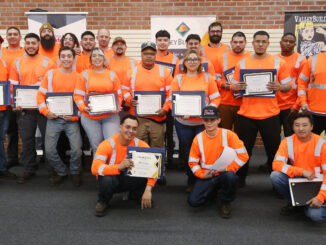
Central Valley Workshops That Pave the Way to Careers in Masonry
by Raul Clement
For over a decade, ValleyBuild, a pre-apprenticeship program in the Central Valley, has provided aspiring workers with a critical introduction to the construction industry. The program exposes participants to the fundamentals of various building trades, paving the way to high-paying union jobs.
One way students explore these trades is through workshops. In the Fresno area, for example, the Fresno Regional Workforce Development Board has partnered with a local union to add a Cement Mason’s Workshop to the ValleyBuild curriculum. The workshop meets twice during the six-week program, giving students hands-on experience in cement work.
“It gives them the ability to taste the different trades and follow their passion,” says Veronica Godinez, Training Director for the Northern California Cement Masons Joint Apprenticeship and Training Committee (JATC). “Each trade has its particular requirements and personality. Pre-apprenticeship helps them figure out which trade will suit them best.”
“The trades, to me, are probably the best thing that can happen to young people.”
Santiago Pino, Retired cement mason and masonry workshop instructor
“We show them everything that has to do with concrete,” says Santiago Pino, the instructor for the workshop. “They get a lot of hands-on experience.”
Pino’s credentials speak for themselves. He spent more than 32 years as a union-certified cement mason, retiring at age 55 with a pension. Since then, he has continued to be involved with his trade through teaching. Over the years, he has seen a lot of changes in the industry.
“I did my pre-apprenticeship back in ’83,” Pino says. “It was nothing like it is now. Now it’s way more organized.”
Another way the industry has changed is a greater focus on inclusivity. ValleyBuild has recently added ValleyBuild NOW, an all-female cohort aimed at providing more opportunities for women in a male-dominated industry. Only 4% of workers on construction sites are women, and women make up only 11% of the building trades workforce overall.
Godinez knows from personal experience the importance of showing women a viable path into the industry.
“I’m a third-generation concrete finisher,” she says. She recalls that seeing a female instructor during her apprenticeship gave her confidence. “When I signed up for my apprenticeship program, and I saw a female instructor in front of me, I knew that I was home. I knew that I was in the right place. If I can see my gender up in front of that class, I can make it in this trade. It’s important for future generations to see women in the trades so they can envision themselves in those roles too.”
Pino, who has taught workshops to ValleyBuild NOW students, has also seen the benefits.
“They’re there for it,” he says of his female students. “They know what they want and are ready to do it. A female worker has great chances these days.”
But despite greater inclusivity, cement masonry isn’t a job for everybody. It’s a physically demanding trade, and the hours can fluctuate. While a couple of workshops over six weeks can’t possibly simulate the rigors of on-site labor, they can at least give students the ability to compare cement work with other building trades.
“Cement masons are often the first ones on site,” says Godinez. “How we’re going to pour, is it a hot day, is it a cold day, what equipment are you running—all those elements play a role.”
Pino agrees. “It’s not a clock-in and clock-out kind of job,” he says. He adds that organized labor ensures fairness, explaining, “You work overtime one day, and maybe the next the boss lets you go home early with pay.”
In addition to ensuring fair pay and on-the-job treatment, unions also offer great benefits workers can’t find elsewhere.
“The security of having a pension, having vacation pay, having health care for your family—you feel good compared to people who don’t have benefits,” Pino says. “They’re going to have to work until they’re 75 years old.”
In fact, it was partially Pino’s strong belief in the value of union construction work that led him to teaching despite being retired.
“The trades, to me, are probably the best thing that can happen to young people.”
For more information about ValleyBuild’s programs, visit them online at valleybuild.net or call 855-805-7245.



